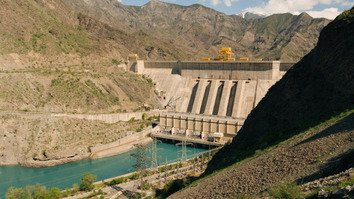Central Asia has made tremendous strides in socio-economic development in recent years, reducing poverty rates from more than 80% just a few decades ago to about 30% today. However, rising climate and disaster risks are threatening the safety and livelihood of communities that call the region home, according to a World Bank statement in January.
By the end of the century, temperatures there could increase by up to 4 degrees Celsius, exacerbating impacts from extreme weather events like floods, landslides, mudflows, droughts, high winds and avalanches -– hazards that already pose major risks to vulnerable communities.
For example, as much as 30% of Central Asia's workforce relies on farming and livestock for livelihood, with well-established practices passed down through generations. Weather variability driven by climate change, however, could slash agricultural production by up to one-third, creating food insecurity and constraining economic growth throughout the region.
Unpredictable rainfall, snowfall and snow and glacial melt can also disrupt hydropower generation, an important part of Central Asia's path towards renewable energy. These power stations provide communities with clean and reliable electricity to power homes, schools and the region's growing economy.
![A bustling market is shown in Khujand, Tajikistan. [Christina Stuhlberger/Zoï Environment Network]](/cnmi_ca/images/2019/02/18/16665-wb1-585_329.jpg)
A bustling market is shown in Khujand, Tajikistan. [Christina Stuhlberger/Zoï Environment Network]
Weather and hydrological forecasting, and long-term climate information, could help make communities safer and more resilient by enabling early warning systems, protecting agricultural yields, increasing hydropower output and identifying important investments in infrastructure.
However, to achieve these benefits, the capacity for hydrometeorological services needs to be improved throughout the region.
$28 million invested in forecasting and information sharing
To help address this challenge, the World Bank, through the Central Asia Hydrometeorology Modernisation Project, has already invested $28 million into modernising monitoring networks, improving forecasting facilities and skills and enabling regional information sharing.
The project helped to rehabilitate 33 weather stations and three river stations in the Kyrgyzstan, and 54 weather stations and 16 river stations in Tajikistan.
These efforts helped improve the capacity of countries to monitor and transmit real-time weather, climate and water measurements, contributing to the increasing of weather and river forecasting accuracy by 30% or more.
Better access to critical weather and hydrological data will deliver significant benefits to the region by boosting agricultural production, ensuring better preparedness for natural disasters and improving climate resilient planning in the most critical sectors -- agriculture, food security, water resources, energy, public health and transportation.
The project provided cutting-edge technical equipment -- such as modern workstations, automated observation networks, access to satellite data, and numerical weather prediction -- coupled with specialised trainings for participating agencies, delivered by multiple partners including the Global Facility for Disaster Reduction and Recovery (GFDRR), the World Bank and the World Meteorological Organisation.
Timely information delivery
These improvements are also helping expand the delivery network for weather information services to get timely information to those who need it most.
As part of the complementary World Bank/GFDRR Strengthening Early Warning of Mountain Hazards in Central Asia project, more than eight technical trainings on modeling, assessment and forecasting of extreme weather, flash floods, mudflows, landslides and avalanches were held for all five countries in Central Asia.
Facilitated by European and Central Asian specialists, with additional inputs and in some cases field training from the European Severe Storms Laboratory and the Kazakh State Agency for Mudflow Protection, more than 100 professionals benefited from the trainings.
Recently, the project received $11.5 million in additional financing, ensuring that these important efforts will continue to help make Central Asia more resilient to climate change and natural disasters -- whatever weather comes its way.
[The World Bank Group authorises the use of this material subject to the terms and conditions on its website, http://www.worldbank.org/terms.]

![A goatherd is shown on the way to pastures on the northern slopes of the Tien Shan mountains, Kyrgyzstan. [Christina Stuhlberger/Zoï Environment Network]](/cnmi_ca/images/2019/02/18/16666-wb2-585_329.jpg)
![Drought-impacted produce is shown in Tajikistan. [Christina Stuhlberger/Zoï Environment Network]](/cnmi_ca/images/2019/02/18/16671-wb3-585_329.jpg)
![A hydropower station is shown in Kyrgyzstan. [Christina Stuhlberger/Zoï Environment Network]](/cnmi_ca/images/2019/02/18/16672-wb4-585_329.jpg)
![A weather station manager is shown in Kyrgyzstan. [Christina Stuhlberger/Zoï Environment Network]](/cnmi_ca/images/2019/02/18/16673-wb5-585_329.jpg)
![Modernised weather forecasting facilities are shown in Kyrgyzstan. [Christina Stuhlberger/Zoï Environment Network]](/cnmi_ca/images/2019/02/18/16674-wb6-585_329.jpg)
![A rehabilitated weather station is shown in Kyrgyzstan. [Christina Stuhlberger/Zoï Environment Network]](/cnmi_ca/images/2019/02/18/16675-wb7-585_329.jpg)
![Fuel trucks ascend Anzob Pass in Tajikistan. [Christina Stuhlberger/Zoï Environment Network]](/cnmi_ca/images/2019/02/18/16676-wb8-585_329.jpg)
![Modernised weather forecasting equipment is shown in Tajikistan. [Christina Stuhlberger/Zoï Environment Network]](/cnmi_ca/images/2019/02/18/16677-wb9-585_329.jpg)
![A woman in traditional clothes checks the weather forecast on her mobile phone in Nurek, Tajikistan. [Christina Stuhlberger/Zoï Environment Network]](/cnmi_ca/images/2019/02/18/16678-wb10-585_329.jpg)
![A World Bank/Global Facility for Disaster Reduction and Recovery field training exercise takes place in Kazakhstan. [World Bank]](/cnmi_ca/images/2019/02/18/16679-wb11-585_329.jpg)
![Children head to school in Kyrgyzstan. [Christina Stuhlberger/Zoï Environment Network]](/cnmi_ca/images/2019/02/18/16680-wb12-585_329.jpg)






